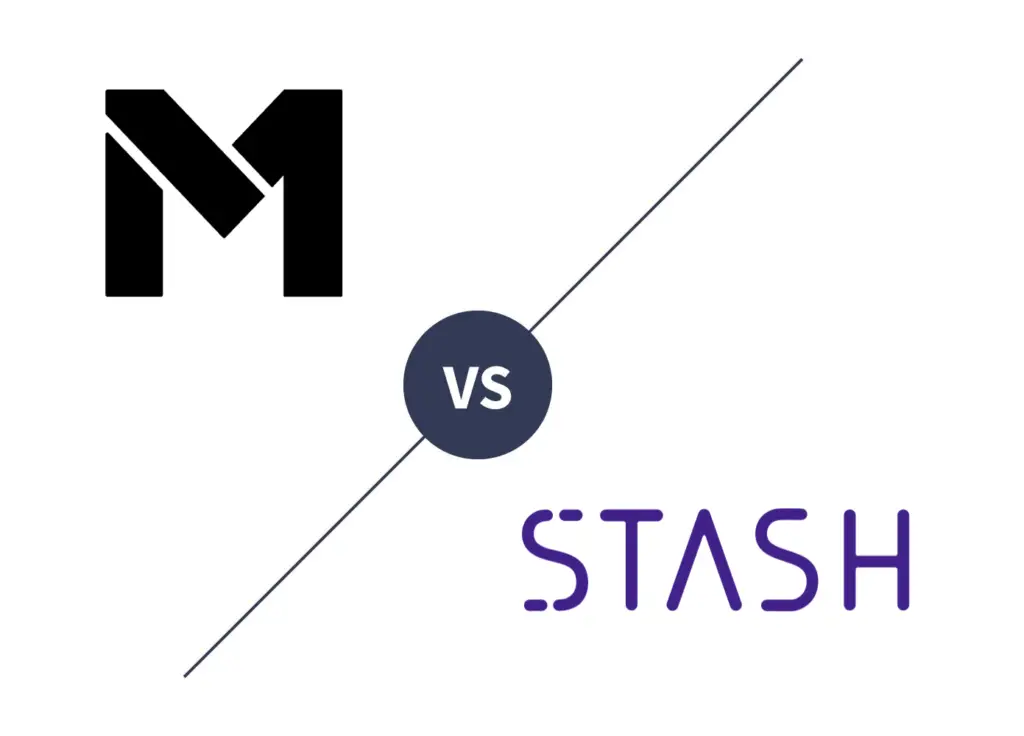
New-age, low-cost investment platforms like M1 Finance and Stash are becoming more popular as investors wisen up to fees and commissions that have historically been largely overlooked. Here we'll compare the two. I wrote a separate comprehensive review of M1 Finance here if you're interested in seeing the specifics of the platform.
Disclosure: Some of the links on this page are referral links. At no additional cost to you, if you choose to make a purchase or sign up for a service after clicking through those links, I may receive a small commission. This allows me to continue producing high-quality, ad-free content on this site and pays for the occasional cup of coffee. I have first-hand experience with every product or service I recommend, and I recommend them because I genuinely believe they are useful, not because of the commission I get if you decide to purchase through my links. Read more here.
M1 Finance vs. Stash – Summary Comparison
Contents
M1 Finance vs. Stash – Commissions and Fees
Stash and M1 Finance both offer commission-free trades. M1 has zero account fees, aside from the obvious miscellaneous fees for things like paper statements, outbound account transfers, inactivity, etc.
Stash has 3 tiered account levels with different fees and different features:
- All 3 account levels have a taxable investment account and a bank account.
- Their Beginner plan at $1/mo. is just a taxable investment account.
- The Growth plan at $3/mo. includes access to retirement accounts in the form of a Traditional or Roth IRA.
- The Stash+ plan is $9/mo. and adds access to custodial accounts to invest for 2 kids, a metal card for the bank account, and a monthly market insights report.
M1 Finance vs. Stash – Account Types
M1 Finance offers taxable, joint, Traditional IRA, Roth IRA, Rollover IRA, SEP IRA, Trust, and Custodial (M1 Plus members) accounts. They currently do not offer SIMPLE IRA, 401(k), Solo 401(k), 529, HSA, or Non-Profit accounts.
Stash only offers taxable, Traditional IRA, Roth IRA, rollover accounts, and custodial investment accounts. IRA's are only available with their mid-grade “Growth” plan at $3/mo., and custodial accounts are only available with their Stash+ plan at $9/mo. Stash does not offer SIMPLE IRA, SEP IRA, Trust, 401(k), Solo 401(k), 529, HSA, or Non-Profit accounts.
Both M1 and Stash also offer an FDIC-insured bank/checking account with debit card.
M1 Finance vs. Stash – Investment Products
M1 Finance offers most ETF's and individual stocks that are traded on major exchanges.
Stash offers individual stocks and a small handful of broad index ETF's.
If you want more ETF choices, go with M1 Finance.
Neither M1 Finance nor Stash has futures, options, crypto, and forex.
M1 Finance vs. Stash – Margin
Stash does not offer margin.
M1 Finance has great margin rates:
- M1 Finance – 3.50%
- M1 Plus – 2.00%
M1 Plus is a $125/year premium membership that gets you access to a lower margin rate as shown, as well as a second afternoon trading window.
Aside from leveraging your portfolio, M1's margin loan can be used for anything you want – refinancing higher-interest debt, major purchases, unexpected expenses, etc.
Remember that margin is an additional risk, including the risk of losing more than you invest. Margin is not available for retirement or custodial accounts. Rates may vary.
M1 Finance vs. Stash – Mobile App
M1 Finance has a sleek, intuitive, user-friendly, robust mobile app for both Apple iOS and Android:
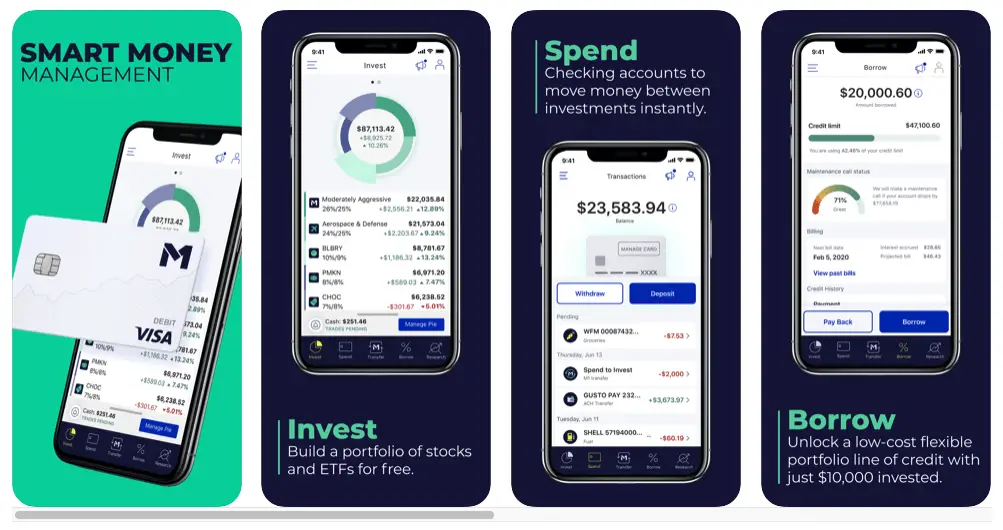
Stash also has a great mobile app, but Android users seem to have a harder time with it. Here are some screenshots of Stash's mobile app:

M1 Finance vs. Stash – Interface/Usability
Both M1 Finance have intuitive, modern, user-friendly interfaces that should be easy to navigate for beginner and seasoned investors alike. Here is M1's interface:
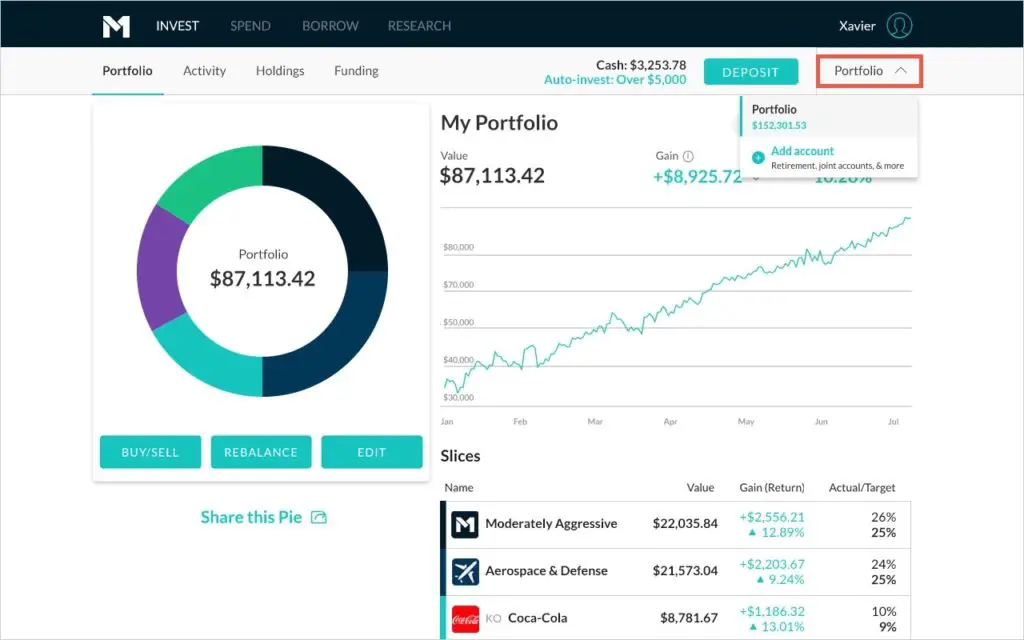
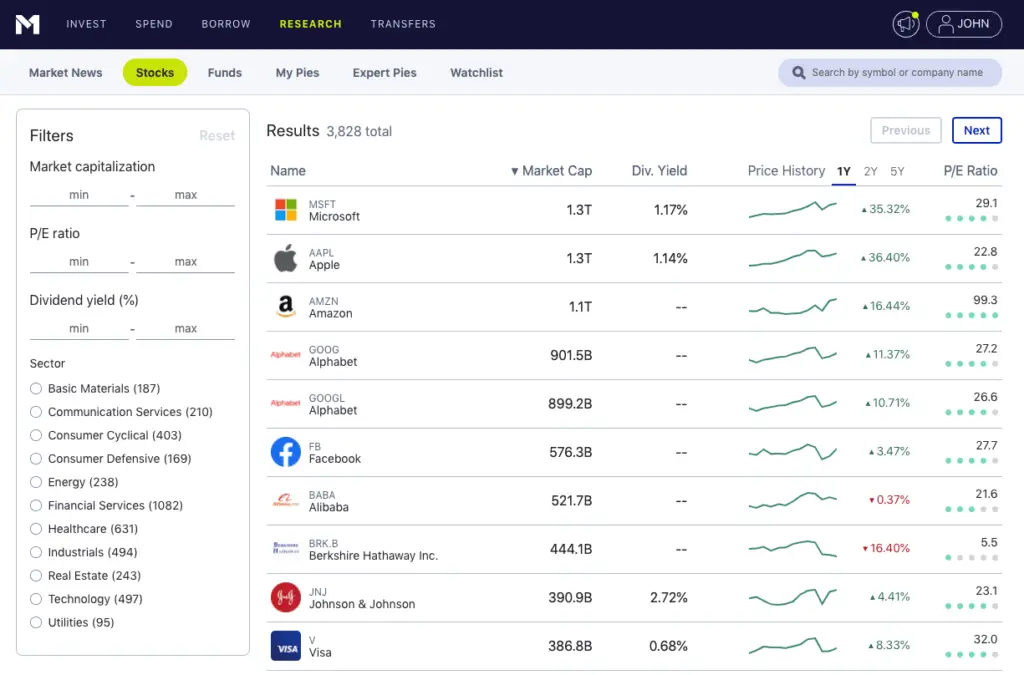
And here are some screenshots of Stash's interface:
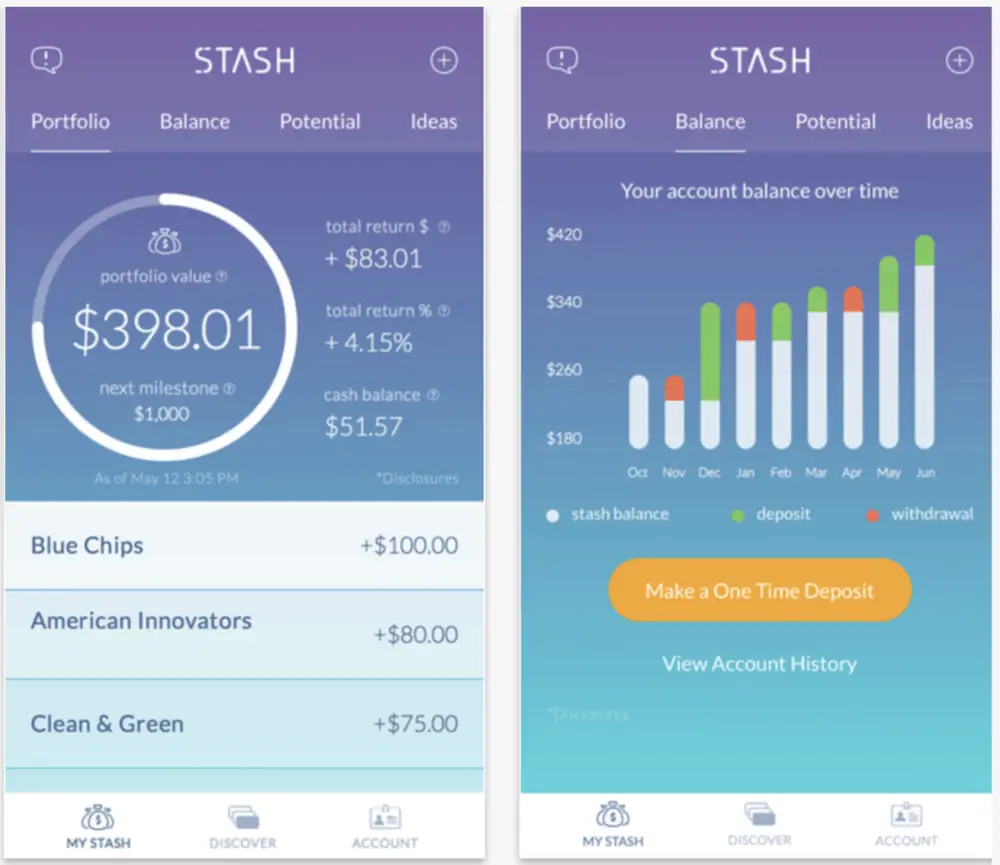
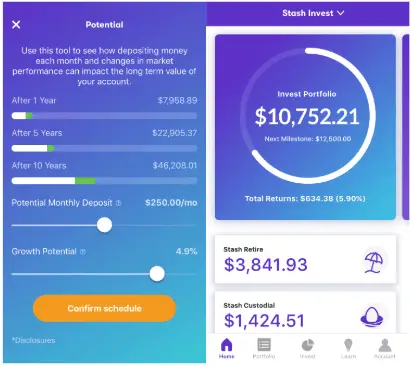
M1 Finance vs. Stash – Extra Features
- M1 Finance and Stash both offer some basic research and education resources for stocks, ETF's, and investing in general. M1 has expert-built “Expert Pies” that you can invest in for free.
- Stash does not offer M1's famous “dynamic rebalancing,” which automatically allocates new deposits to maintain your portfolio's target allocations.
- Both platforms offer fractional shares, allowing even a small amount of money to go to work for you in your portfolio.
- M1's bank account is interest-bearing and earns cash back if you are a member of their premium M1 Plus option. Stash's bank account earns you additional shares of stock as part of their Stock-Back® program.
- Stash lets you access your direct deposits up to 2 days early, stating that you can “get paid up to 2 days early.”
- Orders on both platforms are queued up and executed during their trading windows; they do not offer all-day trading or advanced order control.
- M1 brings a social aspect to investing, allowing you to share your Custom Pies via a hyperlink.
- M1 offers automatic dividend reinvestment (DRIP) at the portfolio level. Stash does not automatically reinvest dividends for you.
M1 Finance vs. Stash – Summary and Conclusion
- Both M1 Finance and Fidelity offer zero-commission trades. M1 doesn't have account fees; Stash has small monthly account fees that differ based on your needs, ranging from $1/mo. to $9/mo.
- M1 Finance has a few more account types than Stash, namely SEP IRA and Trust accounts. Stash offers custodial accounts on their premium Stash+ plan, while M1 does not.
- M1 Finance offers most ETF's and individual stocks. Stash offers a smaller selection of ETF's and most stocks.
- M1 Finance offers great margin rates. Stash does not offer margin.
- Both platforms have modern, intuitive desktop web and mobile app interfaces.
- Both platforms offer an FDIC-insured bank account with a debit card. M1's bank account is eligible for cash back and interest with their premium M1 Plus membership. Stash has a Stock-Back® program that gives you additional stock shares.
- Stash lets you access your direct deposits up to 2 days early.
- Both M1 Finance and Stash offer fractional shares.
- Stash does not have automatic rebalancing like M1.
- Neither platform offers advanced order control.
- Free expert resources like M1's “Expert Pies” are not available on Stash. Stash does include a monthly market insights report with their premium Stash+ plan at $9/mo.
- M1 allows you to share your Custom Pies via a hyperlink and invest in the Custom Pies of others, such as these “lazy portfolios.”
Both M1 Finance and Stash will provide significant savings in fees over other brokers and traditional banks. In general, Stash seems more focused on their bank account offerings and less on their investing platform. That is, the fact that you can invest seems secondary to their bank account feature. This is just the takeaway feeling I got from their website and shows in their limited offering of ETF's. It is suitable for beginner investors, but is likely too limited for sophisticated investors. M1, on the other hand, is primarily an investing broker with an optional bank account, and is suitable for both beginner and experienced investors alike.
I think your choice between these two platforms depends largely on what account types, products, and features you need access to, as well as how experienced you are and how hands-on you want to be.
If you want access to margin, more ETF's, automatic rebalancing, SEP IRA's, and Trust accounts, M1 Finance would be the better choice. M1 would also be the better choice if you want a set-and-forget lazy portfolio or Expert Pie that automatically rebalances. I wrote a separate comprehensive review of M1 Finance here if you're interested in seeing the specifics of the platform.
M1 currently has a promotion for up to $500 when initially funding an investment account:
Disclaimer: While I love diving into investing-related data and playing around with backtests, this is not financial advice, investing advice, or tax advice. The information on this website is for informational, educational, and entertainment purposes only. Investment products discussed (ETFs, mutual funds, etc.) are for illustrative purposes only. It is not a recommendation to buy, sell, or otherwise transact in any of the products mentioned. I always attempt to ensure the accuracy of information presented but that accuracy cannot be guaranteed. Do your own due diligence. I mention M1 Finance a lot around here. M1 does not provide investment advice, and this is not an offer or solicitation of an offer, or advice to buy or sell any security, and you are encouraged to consult your personal investment, legal, and tax advisors. All examples above are hypothetical, do not reflect any specific investments, are for informational purposes only, and should not be considered an offer to buy or sell any products. All investing involves risk, including the risk of losing the money you invest. Past performance does not guarantee future results. Opinions are my own and do not represent those of other parties mentioned. Read my lengthier disclaimer here.

Are you nearing or in retirement? Use my link here to get a free holistic financial plan from fiduciary advisors at Retirable to manage your savings, spend smarter, and navigate key decisions.
Don't want to do all this investing stuff yourself or feel overwhelmed? Check out my flat-fee-only fiduciary friends over at Advisor.com.
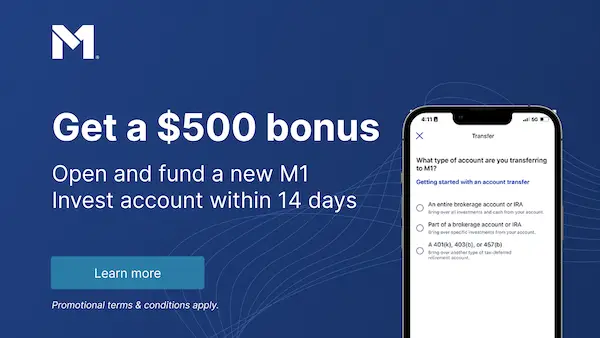

Leave a Reply